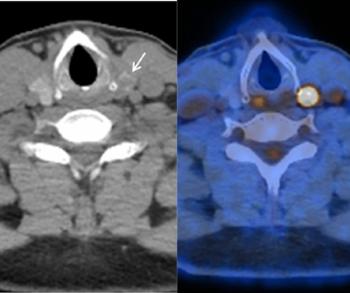The computed tomography (CT) vascular sign may be a key indicator of whether a solid pulmonary nodule is malignant or benign, according to a new study.
For the retrospective study, recently published in Academic Radiology, researchers compared a diagnostic model looking at clinical and morphological features for solid pulmonary nodules (SPNs) versus a model that considered the CT vascular sign in addition to the aforementioned features. The cohort was comprised of 231 patients with benign SPNs and 200 patients with malignant SPNs.
The study authors found that type I or type II CT vascular signs were present in 88.8 percent of patients with benign SPNs. Type IV CT vascular signs were noted in 74 percent of patients with malignant SPNs, according to the study authors.
Inclusion of the CT vascular sign for assessment of SPNs led to a 13.3 percent higher AUC (89.2 percent vs. 75.9 percent), a 7.5 percent increase in sensitivity (92.5 percent vs. 85 percent) and a 16.9 percent increase in specificity (76.9 percent vs. 60 percent) in comparison to the diagnostic model that did not include the CT vascular sign.
“CT vascular signs, which reflect the spatial relationship between pulmonary vessels and SPNs, can reveal the growth patterns of nodules and provide valuable clues for differential diagnosis,” wrote lead study author Yu Peng, M.D., who is affiliated with the Department of Radiology at the First Affiliated Hospital of Chongqing Medical University in Chongqing, China, and colleagues.
External validation testing demonstrated a 16.9 percent reduction in the false positive rate (23.1 percent vs. 40 percent) and a 7.5 percent reduction in false negatives (7.5 percent vs. 15 percent) with the inclusion of the CT vascular sign in evaluation of SPNs, according to the researchers.
Three Key Takeaways
- CT vascular signs improve diagnostic accuracy. Incorporating the CT vascular sign into a diagnostic model for solid pulmonary nodules (SPNs) increased AUC by 13.3 percent, sensitivity by 7.5 percent, and specificity by 16.9 percent compared to a model without it.
2. Distinct vascular sign patterns correlate with malignancy. Type I–II CT vascular signs were predominantly associated with benign SPNs (88.8 percent) while type IV signs were strongly linked to malignant SPNs (74 percent), with a 16.8-fold higher likelihood of malignancy.
3. Enhanced diagnostic performance and clinical utility. Adding CT vascular sign analysis reduced false positives by 16.9 percent and false negatives by 7.5 percent, suggesting value in refining differentiation of benign versus malignant nodules and improving clinical decision-making.
In binary logistic regression analysis, the study authors found that lobulation, spiculation and the bronchial cutoff sign were over 4.3 times, over 2.3 times and four times more likely to be associated with malignant SPNs. In contrast, the study authors found that the type IV CT vascular sign was over 16.8 times more likely to lead to diagnosis of a malignant SPN.
“Beyond conventional nodular morphological characteristics, detailed assessment of the spatial relationship between SPNs and adjacent pulmonary vessels significantly improves diagnostic accuracy and supports improved clinical management,” added Peng and colleagues.
(Editor’s note: For related content, see “Can the Use of CT-Based AI Lead to Earlier Detection of Progressive Pulmonary Fibrosis?,” “Can AI-Enhanced Radiomics Improve Differentiation of Pulmonary Nodules on Chest CT?” and “CT Study: Modified Lung-RADS Model Offers Enhanced Prognostic Assessment of Pure Ground-Glass Nodules.”)
In regard to study limitations, the authors acknowledged the limited amount of non-adenocarcinoma cases in the cohort, the potential for interobserver variability and the lack of comparison for CT vascular signs across different SPN sizes and between solid and subsolid pulmonary nodules.




























